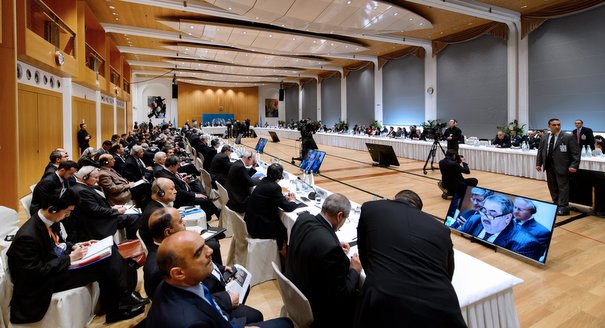The Syrian peace conference known as Geneva II has just restarted after a weeklong pause, but the results so far are meager. Despite an evacuation of civilians from Homs, there has been no visible progress on the issue for which the conference was officially convened: negotiating a “transitional governing body” able to move Syria from rule by President Bashar al-Assad and his family toward a more inclusive and internally stable political system.
Many point to regional influence over the actors on both sides of the conflict as a reason for this blockage and, consequently, as the key to ending the deadlock. If Iran, which supports Assad, and Saudi Arabia, which supports the opposition, could be drawn into direct talks over Syria, so the argument goes, these regional powers might be able to balance their interests among themselves. They could then agree to symmetrically scale down their support to the warring sides, thereby dampening the conflict and creating the conditions for a settlement in Syria.
But the role of regional state players in the exacerbation of the conflict should not be exaggerated. Neither Iran nor Saudi Arabia is primarily responsible for the conflict’s sectarian turn. Rather, they have been dragged into a sectarian conflict that long predates their rivalry. The conflict’s transformation into an all-out war—which dates to early February 2012, when the regime began using heavy artillery against Homs—occurred before there had been any significant Saudi involvement on the rebel side, although Iran was already funding and supporting Assad’s government at that time.
The Syrian conflict is first and foremost about sectarian power sharing inside Syria. It cannot be solved while Assad and his fellow members of a small religious minority, the Alawites, exert total control over the military-security apparatus. For as long as this fundamental internal imbalance remains, Syria will remain a black hole irresistibly attracting external players—and attempts to resolve the conflict by focusing only on its regional dimension will be doomed to fail. Any credible peace effort requires negotiations that deal with the root problem and the demand for real political transition.
A False Equivalence
In fact, symmetrically and simultaneously reducing support for both sides in Syria would probably do more harm than good since it would not affect the two sides evenly. Rather, it would create a new imbalance that could further exacerbate the conflict.
The Syrian government has been importing and stockpiling weapons for decades, and it still runs military factories. This means that Assad could fight for at least several months, if not years, even if his forces were completely cut off from the supply lines currently extended by Russia and Iran. For instance, most of the regime’s current airstrikes against civilian areas in Aleppo and elsewhere are carried out with do-it-yourself “barrel bombs” that need no material input from abroad.
The rebels, on the other hand, have few stockpiles and a very limited support infrastructure to fall back on. Any significant disruption in their external support is likely to swiftly and severely undermine their fighting capabilities. Judging by history, such a disruption would be more likely to encourage the regime to step up its military effort in the hope of total military victory than to make it amenable to constructive compromises in the interest of peace.
Moreover, a freeze in support would not affect all rebel groups equally. Jihadi factions like the al-Qaeda–linked Nusra Front and the Islamic State of Iraq and the Levant, or for that matter the Kurdish nationalist and leftist militia known as the People’s Protection Units, do not rely on over-the-table sources of funding. Instead, they are self-financed or supported by nonstate actors that have already been blacklisted by the international community. They are therefore nearly invulnerable to diplomatic or legal measures imposed from abroad—and while mainstream rebel forces would falter as state supplies diminished, these potential spoiler groups would only grow stronger.
Strong Rebel Forces Needed to Police a Peace Deal
The Assad regime and its Russian and Iranian allies have argued that a peace deal should aim to dismantle Syria’s rebel militias, allowing the official security forces to re-extend their presence into all corners of Syria. But this is a disingenuous argument, since the current loyalist forces can neither act as the sole pillar of Syria’s future security architecture nor credibly integrate major rebel militias into their command structure.
Over the last three years, the Syrian Arab Army and its affiliate militias have undergone transformations that mirror those of the armed opposition: they have become more homogeneously Alawite and absorbed large numbers of civilians recruited along sectarian lines, they have radicalized by embracing a sectarian anti-Sunni discourse, they have grown over-reliant on Shia Islamist foreign fighters (far more than the opposition), and they have established their own mafia-like war economy.
Because of all these flaws, loyalist forces are not fit for reestablishing order and security in regions now controlled by the opposition, even after a ceasefire. In those regions, the new security architecture must primarily rely on rebel forces themselves. This means that some form of logistical support for opposition forces will be necessary before, during, and after a peace process if these forces are to effectively provide law and order, contain extreme elements of the insurgency, and sustain a peace deal. And this, too, means that any peace agreement will have to address the most fundamental grievances of the Syrian opposition—namely, it will have to achieve a political transition away from today’s minoritarian and exclusionary power structure and give the opposition a real stake in Syria’s future order.
Thomas Pierret is a lecturer in contemporary Islam at the University of Edinburgh and the author of Religion and State in Syria: The Sunni Ulama from Coup to Revolution (Cambridge University Press, 2013).






